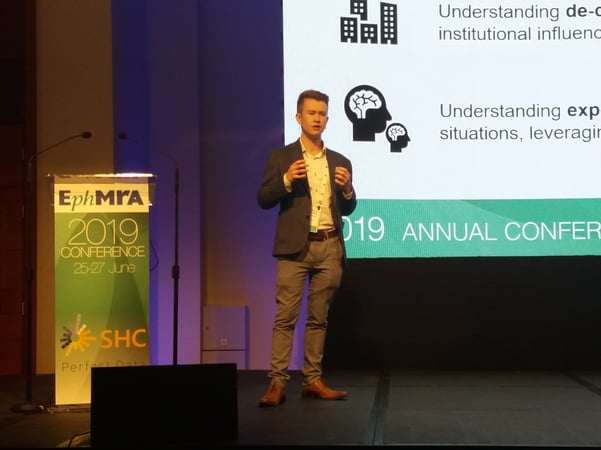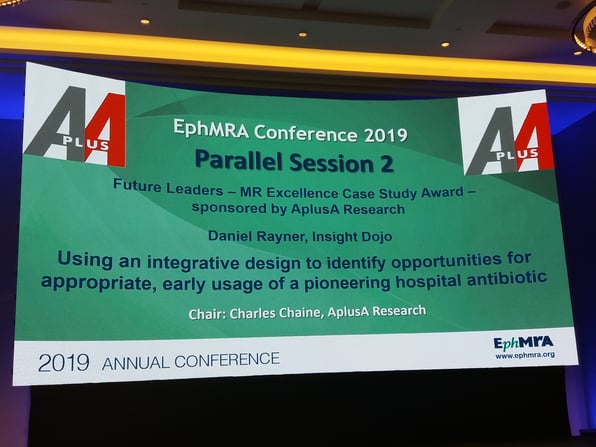The BLOG
This blog provides exclusive content for market researchers and marketing managers involved in Healthcare Marketing, prepared by APLUSA teams, and includes APLUSA important news updates.
EphMRA 2019: Future Leaders Winning Case Study
AplusA sponsored this year's EphMRA Future Leaders Award, won by Daniel Rayner for Insight Dojo. Supporting young professional development in the market research industry is at the heart of our development as an organization, and we are always proud to champion and celebrate future talent in our industry. We believe that combining the advanced technological capabilities emerging in market research with the best new talent and market knowledge results in the ability and opportunity to push our industry to great new limits.

Developing launch strategies for innovative drugs requires an innovative approach. At EphMRA Warsaw in June this year, Future Leaders Award Winner Daniel Rayner discussed Insight Dojo's pioneering approach to developing the launch strategy of a new hospital antibiotic for the treatment of highly resistant infections. As the post conference news is published by EphMRA this week, we take a look back at the winning case study in this category.
Insight Dojo was commissioned to help develop the European product and marketing strategy for a pioneering new antibiotic, product x, developed for the treatment of highly resistant hospital-acquired infections. The aim was to maximize the value of the antibiotic by identifying opportunities for appropriate early use, rather than saving it as a last resort.
Product x was situated in a challenging decision-making environment:
-
The influence of environmental pressure on decision making, due to the wider healthcare implications of the overuse of antibiotics
-
De-centralized decision making, due to the presence of institutional influences on physician behavior
-
Expert decision making in fast, high risk, but low information situation, leveraging influential behavioral psychologist,Gary Klein’s work.
Daniel Rayner outlined an innovative methodology to help identifying opportunities for appropriate early use of the product.
The innovative approach consisted of three innovative methods:
- First, a ‘naturalistic’ qualitative design
- Second, a quantitative phase with classic segmentation and machine learning
- Third, a novel non-conscious method: the mouse tracker
The purpose of the naturalistic qualitative design was to recreate a real decision-making environment for physicians. In this phase, a ‘diary study’ was included to capture real-time patient case histories. Dynamic patient profiles, that unfolded over time, and joint specialty interviews, such as an infectious disease specialist with a microbiologist, were also included to capture real discussions about patients.
In the quantitative phase, mixed-mode cluster analysis with ‘random forest’ machine learning algorithms was applied to identify target physicians as well as to provide predictive insights.

The mouse tracker was used to understand latent and non-conscious processes. Mouse tracking is a novel non-conscious method to uncover response dynamics and the continuity of the mind. The mouse tracking provided three outcomes: it identified hidden segments, highlighted real competitive sets and identified real motivators and barriers.
The success of the project depended on the client engagement during the study. It was vital to ensure client-side knowledge and expertise to be integrated into this research. Periodic problem-solving workshops were conducted. A cross-functional team, including medical specialists, provided creative thinking and learnings.
Four strategic actions for the early use of product x were generated:
-
Identified and sized four ‘Hot States’ in the treatment journey where physicians felt there were unmet needs
-
Identified five physician segments (and which one each physician fell into). Two were potential early adopters
-
Stratified hospitals to identify those best set-ups for early use
-
Developed core positioning and message development for target segments
Four key takeaways from Daniel Rayner’s case study:
-
Resolution focused leadership
-
Cross-functional engagement
-
Thoughtful insight innovation combining classic and innovative techniques
-
Iterative learning approach ‘top-down’ and ‘bottom-up’ synthesis and communication
AplusA was proud to sponsor the EphMRA Future Leaders – MR Excellence Case Study Award.
"It was a pleasure to see Daniel presenting this innovative approach. He has well deserved the award and we wish him all the best for the future." – Alexander Edte, Business Unit Director AplusA
To keep up to date with AplusA news and events, please follow our LinkedIn page here.
